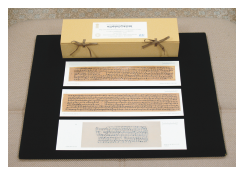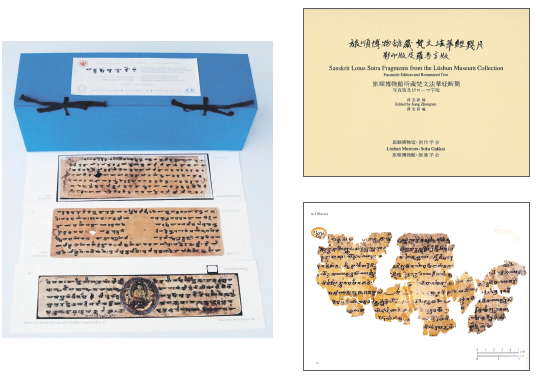




 |
 |
 |
 |
 |
 |
|
The
Institute of Oriental Philosophy
|
Lotus Sutra Manuscripts |
 |
| ‣Three Lineages of Sanskrit Lotus Sutra Manuscripts The
extant Sanskrit Lotus Sutra manuscripts can be classified into three
lineages based on the locations where they were found or copied, i.e.,
the Nepalese group, the Gilgit group, and the Central Asian group.
1. Nepalese group Copy dates: palm leaf (11th-12th centuries CE), paper (since the 17th century CE). More than 30 palm-leaf and paper manuscripts of the Lotus Sutra were found or obtained in Kathmandu Valley, Nepal, and in Tibet. Different from other groups, many of them are almost-complete texts, which makes it possible for the research to classify them into subgroups. Among the palm-leaf texts,①Sanskrit Lotus Sutra Manuscript from the National Archives of Nepal (No. 4-21), Facsimile Edition (below left), and ④ Sanskrit Lotus Sutra Manuscripts from Cambridge University Library (Add. 1682 and Add. 1683), Facsimile Edition, (below right) published in the series preserve comparatively older readings. They are, therefore, of high academic value.  2. Gilgit group Copy dates: 6th-8th centuries CE. Voluminous Buddhist scriptures were found at a site near Gilgit (presently controlled by Pakistan) in Kashmir in 1931. They included manuscripts of the Sanskrit Lotus Sutra, written on birch bark and paper in a Gupta script. As part of the series publications, ⑫ Gilgit Lotus Sutra Manuscripts from the National Archives of India, Facsimile Edition (below) was issued in 2012. It contains the Gilgit manuscripts kept at the National Archives in New Delhi.  3. Central Asian group Copy dates: 6th-10th centuries CE. The Central Asian group is a general term for the Lotus Sutra manuscripts found mostly from ruins of oasis cities along the Silk Road. The most substantive manuscript is the Kashgar manuscript or Petrovsky manuscript, which was obtained by the Russian consul general in Kashgar, Nikolai F. Petrovsky (1837-1908), by 1893. It is estimated that the manuscript was copied in the 8th century CE. Including this manuscript, ⑮ Sanskrit Lotus Sutra Manuscripts from the Institute of Oriental Manuscripts of Russian Academy of Sciences (SI P/5, etc), Facsimile Edition (below left) was issued in 2013 as part of the series publications. There are also manuscripts and fragments named after the finder, collectors, the places where they were found or acquired, or the places of the institutions that now keep them, such as the Khāliq, Farhād-Bēg, Stein, Mannerheim, Trinkler, and Lüshun (Otani) manuscripts. In some cases, fragments of a manuscript were obtained separately and are kept at multiple institutions. The Lüshun manuscripts were published in 1997 as the very first of the series, ⑬ Sanskrit Lotus Sutra Fragments from the Lüshun Museum Collection, Facsimile Edition and Romanized Text (below right). It is estimated that many of the Lüshun manuscripts were found in Khotan. Most of the texts, written in a script of the 5th-6th centuries, bear older readings of the sutra.  |